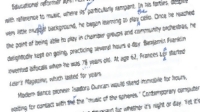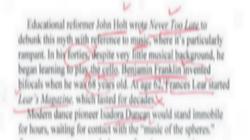When words in a sales
letter, publicity headline or other
marketing piece must persuade, planning for
the mindset of the reader is fundamental.
Today's reader is
skeptical, distracted and easily bored. You
probably realize this, but you may miss many
of the implications of this fact for how you
must put words together to get and keep
attention and move the reader to action.
Here's how to work with
rather than against the mindset of the
reader in persuasive writing.
* Always write with the
specific audience firmly in mind. The main
cause of stilted writing is marketers
putting words together to create a
pie-in-the-sky document rather than to speak
to a certain group of people.
* Use the pronoun "you" as
your primary one rather than "we" or "they."
This not only creates livelier wording, it
more quickly triggers an emotional
connection with you in the reader.
* Avoid dense wording with
negatives that have to be read slowly and
carefully to be understood. Any time you use
two or more "not" type words in one
sentence, you force someone trying to read
quickly into time-consuming mental
somersaults.
* Customer questions that
appear stupid or out of left field may alert
you to points you neglected to include. For
example, you wrote "Hampshire County"
repeatedly without saying whether you meant
the county by that name in West Virginia or
Massachusetts.
* Be explicit in what
exactly you are writing about. Are you
selling a book, an audio CD, a multi-media
learning program or something else? Is this
a downloadable program, a mobile phone
application or a web-based service? It's
astonishing how often writers neglect to
nail down the basic facts.
* Clarify your terminology
instead of assuming the reader understands
your jargon. A first-time home buyer is
likely to get stuck on phrases you take for
granted, like "HUD statement," "LTV," "Title
9" and "Underwriting." Including unobtrusive
definitions keeps readers from feeling lost
or baffled, while not insulting those in the
know.
 |
Improve Your
Proofreading
Quick online course teaches how to
catch pesky typos. Whether you check
writing on screen or on paper, learn the
stakes for error-ridden copy, the five
best proofreading methods and the tools
you can or shouldn't use to identify
errors. Includes practice tests and
answers.
Proofreading Hacks course. |
* Check the readability of
your text, aiming at eighth to ninth grade
level. In the 1930s and 1940s, Rudolph
Flesch and Robert Gunning worked with the
Associated Press and United Press to make
news writing more readable. When the average
reading level of newspapers dropped from the
twelfth to the ninth grade, readership rose
45 percent. The same improvement in results
occurs today with marketing writing on the
web or on paper.
None of these tips dumb
down your message. They merely grease the
delivery path so what you wanted to
communicate more easily gets across.






